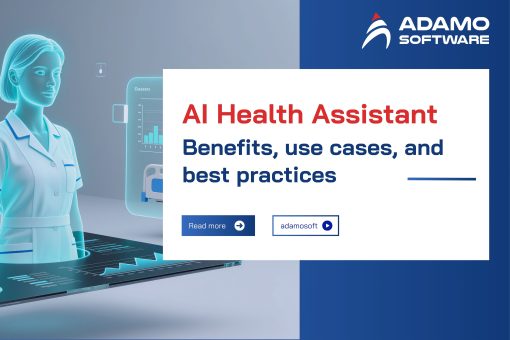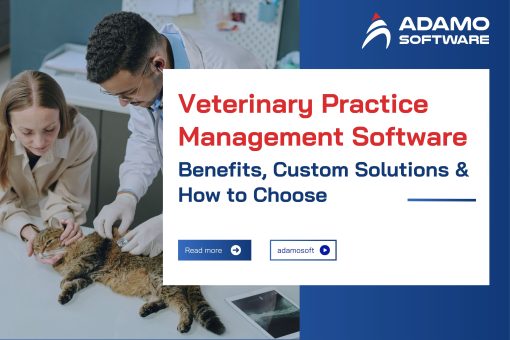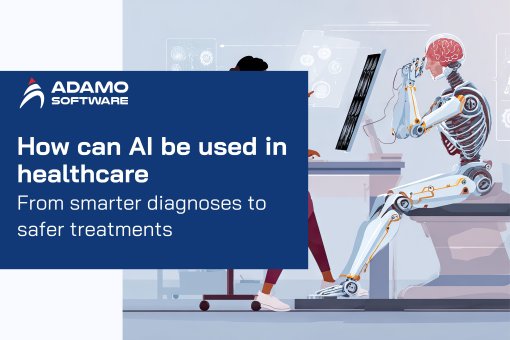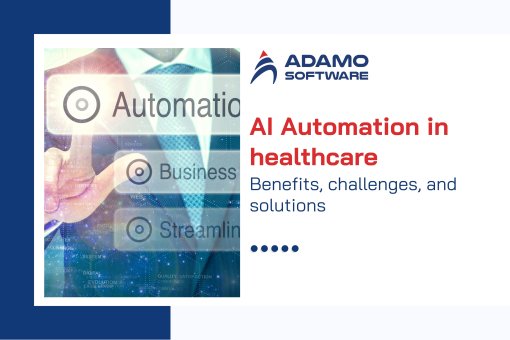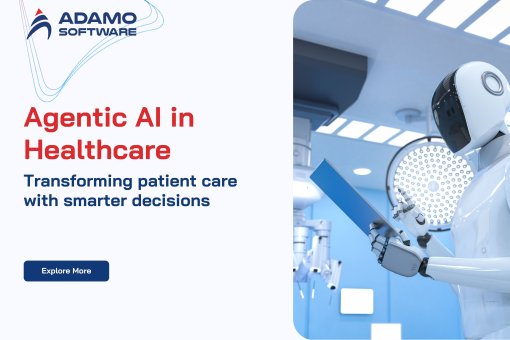Pharma Software types explained: How to find the ideal solution
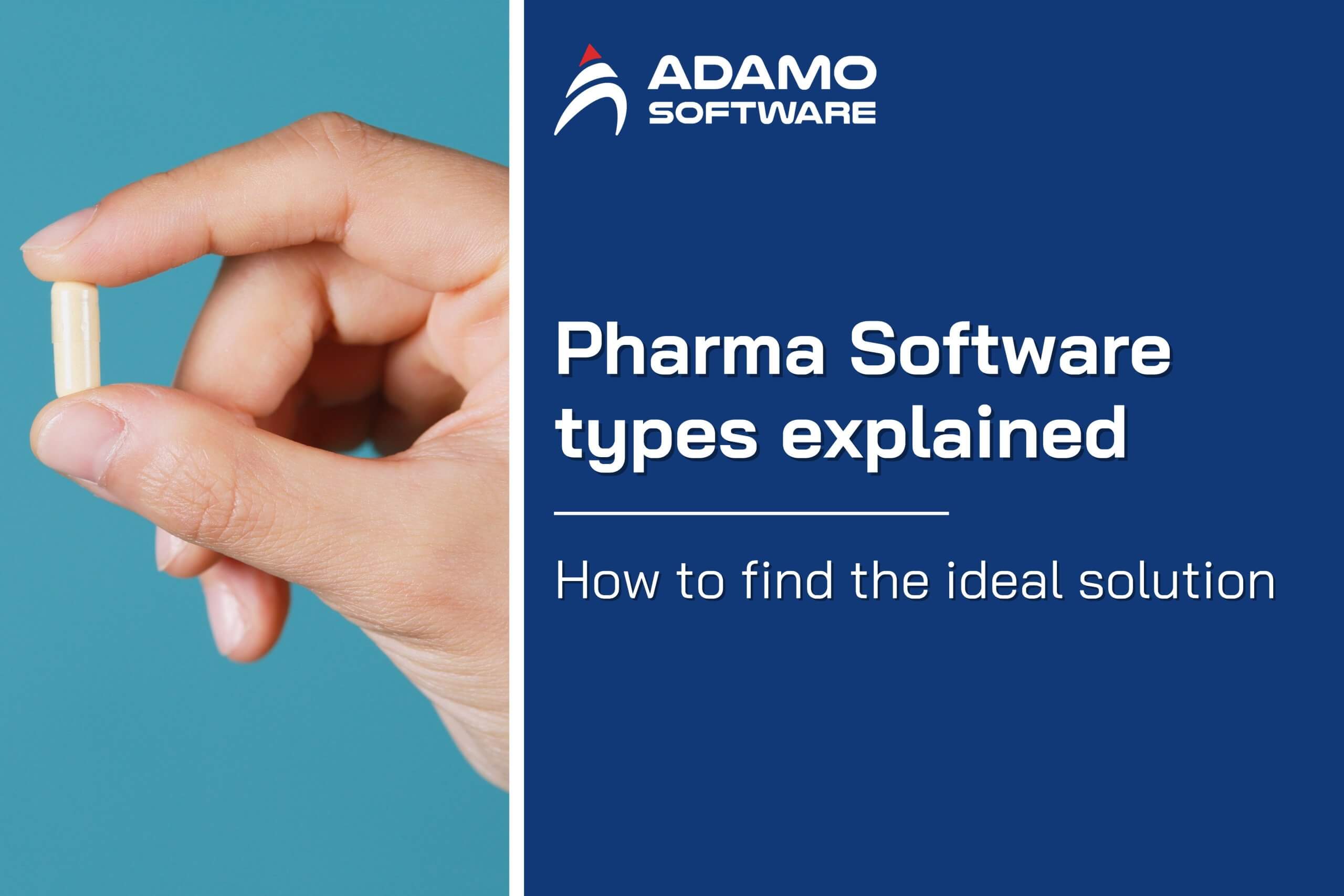
Discover key types of pharma software and how to choose the best solutions to streamline operations, ensure compliance, and boost efficiency in pharma businesses.
Today, pharmaceutical software is no longer an optional tool for forward-thinking pharmaceutical manufacturers. With increasing demands from regulatory bodies like the FDA and ICH for optimized, digital, and streamlined operations, pharmaceutical software has become a core component of how modern pharmaceutical companies function.
From automating quality control processes to improving manufacturing and resource allocation, pharma software has revolutionized the entire drug lifecycle – from research and development (R&D) to distribution and post-marketing monitoring – at least for those companies savvy enough to embrace the technology.
If your business wants to survive and maintain a competitive edge in the future, investing in smart, timely pharma software should be at the top of your priority list.
In this blog, we have compiled a list of top pharma software systems your company should explore and implement in 2025.
I. What is Pharma Software?
Pharmaceutical software is a digital technology solution designed to automate and optimize processes in the pharmaceutical industry. This software integrates tools such as inventory management, drug tracking, invoicing, storing customer and manufacturer information, and maintaining a systematic database.
As a pharmaceutical information system that can centralize data and support supply chain management, pharma software helps pharmaceutical businesses operate more efficiently. At the same time, errors in drug and dosage dispensing are minimized. In addition, many pharmaceutical systems also integrate electronic prescription (e-prescription) features. This contributes to improving the quality of patient care and minimizing manual intervention in sensitive areas.
II. 5 main types of Pharma Software
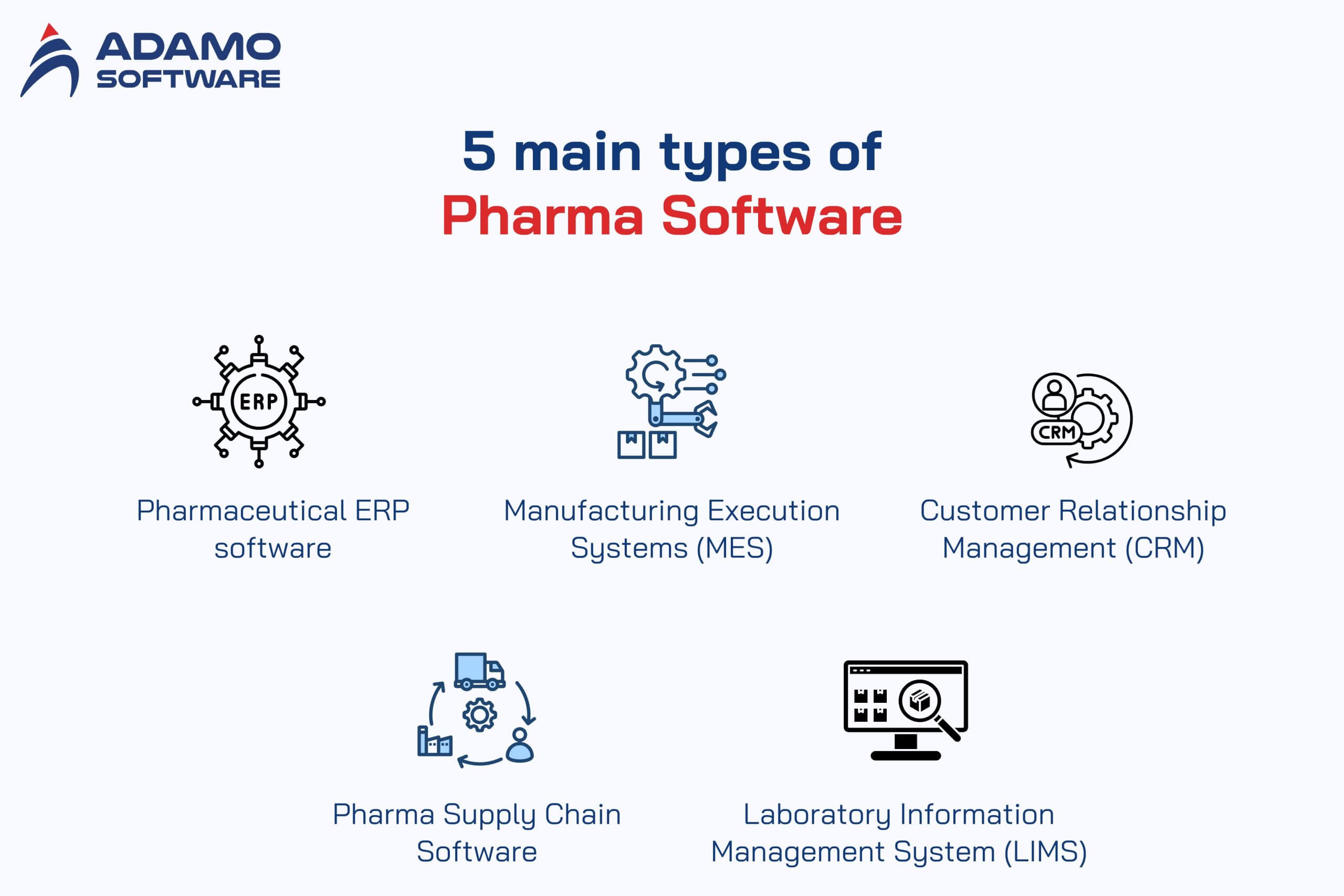
1. Pharmaceutical ERP Software
Pharmaceutical ERP software refers to a digital solution designed to manage and streamline enterprise resource planning processes within the pharmaceutical industry. It provides an integrated and connected view of your key business processes and databases, such as manufacturing capacity, finished drug batches and lots, raw materials, cash, purchase orders, payroll, etc.
Controlling and tracing the origin of pharmaceutical ingredients, packaging, and closures is a key cGMP outlined in FDA 21 CFR Part 211. Therefore, implementing pharma software with integrated ERP is a great way for businesses to easily track active pharmaceutical ingredients (APIs), inventory, warehouses, packaging, and manufacturing processes, as they enter and exit your business. This ensures regulatory compliance and improves operational efficiency.
The most effective pharmaceutical ERP solutions unify data and workflows across various departments—such as finance, procurement, HR, manufacturing, supply chain, sales, and customer support. This integration helps ensure consistency and transparency across the entire organization.
2. Manufacturing Execution Systems (MES)
In pharmaceutical manufacturing software, the MES Manufacturing Execution System is an indispensable component.
MES bridges the pharma ERP software system, which focuses on strategic resource planning, and lower-level control platforms such as SCADA, which monitor machinery and production processes in real time.
Simply put, MES helps track the journey of pharmaceutical ingredients (APIs) from the beginning of production until they are completed and put into final dosage forms (FDFs). With this function, MES becomes the first choice of many pharmaceutical companies when they want to improve the quality and reliability of their products.
In addition to monitoring the production process, pharma software in the form of MES also supports equipment quality analysis, production scheduling, downtime measurement, and product lifecycle management. MES often generates electronic batch records (EBR), an important requirement in cGMP standards that the pharmaceutical industry must comply with.
Moreover, this system also helps pharmaceutical companies in the US meet the obligation to report drug quantities as prescribed in the CARES Act of 2020.
However, when automating the production process according to GMP standards, businesses must pay special attention to GAMP – Good Automated Manufacturing Practice. Because pharmaceutical manufacturing software is directly related to product safety, it is impossible to deploy an unproven system arbitrarily. Just one tiny mistake in the software might cause major problems down the line.
Therefore, testing and confirming the suitability of pharmaceutical manufacturing software is a mandatory step. Ideally, follow the guidance from GAMP 5 – the second edition, combined with the latest standards from the FDA on computer system assurance.
Also read: Pharma Software Solution: Benefits, features & tech stack guide
Explore Our Tailor-made Software Development Solutions
We are confident in providing end-to-end software development services from fully-functioned prototype to design, MVP development and deployment.
3. Customer Relationship Management (CRM)
CRM, or customer relationship management, is essential in any industry interacting with customers.
Pharmaceutical CRM software is an important investment in the pharmaceutical industry that helps businesses effectively manage customer relationships. This is true for both research and contract manufacturing organizations in the pharmaceutical sector, especially when they deploy marketing campaigns or provide services and products on a large scale.
Unlike ERP systems or specialized manufacturing software for the pharmaceutical industry, CRM software often does not have many specific requirements or strict regulations particular to this field. However, pharmaceutical companies still need to demonstrate the ability to control and manage external stakeholders (third parties), although they are not required to comply with many specific standards.
In other words, customer relationships are still customer relationships – regardless of the industry. Therefore, pharmaceutical businesses can still use popular CRM software platforms, as long as they meet core features such as:
- Managing customer databases and contact information
- Automating sales and marketing campaigns
- Tracking the entire process of customer interactions and transactions
4. Pharma Supply Chain Software
Since the COVID-19 pandemic, pharma supply chain software has become an essential tool for pharmaceutical companies. That’s because today’s supply chains are longer, more complex, and carry greater risks than ever before.
The pharmaceutical supply chain encompasses the entire journey of a drug from the manufacturer to the end user, via distributors, pharmacies, or hospitals. Throughout this process, businesses must strictly adhere to quality control requirements, storage conditions (usually temperature), and GDP (Good Distribution Practice) standards.
Pharma supply chain software has many points of intersection with the systems mentioned above.
For example:
- ERP software for the pharmaceutical industry often has built-in functions for inventory management, order processing, and demand forecasting – important elements of supply chain management.
- Pharmaceutical CRM software can help manage a database of supply chain partners such as contract manufacturers (CMOs), distributors, or retailers.
However, to ensure comprehensiveness, many specialized features should still be implemented through specialized supply chain software systems, including:
- Supplier evaluation and approval
- Track, traceability, and batch numbering for each product
- A system to monitor transportation conditions, such as temperature or humidity, ensuring that drugs are not affected during circulation
Given the unique nature of the pharmaceutical industry, businesses may need multiple pharmaceutical supply chain software and interactive pharmaceutical distribution software systems to meet their operational and regulatory needs. This helps ensure smooth operations while complying with regulations. This should not be a single system, but a group of solutions that must be designed synchronously and compatible.
5. Laboratory information management system (LIMS)
The last type of pharma software on the list is the LIMS system, short for Laboratory Information Management System.
- If your company runs a laboratory, LIMS software is an essential tool. Initially, LIMS platforms were used to track and manage samples throughout the analysis process. However, over time, they have been expanded with more modern features such as:
- Managing instrument calibration and maintenance
- Entering and storing analysis results (assay results)
- System integration, electronic data exchange between equipment and software in the lab
- Tracking chemicals, reagents, and batch numbers
- Building a digital workflow, from sample receipt to data entry
Thanks to these features, LIMS software helps labs maintain compliance with GLP (Good Laboratory Practice) standards while simplifying quality control procedures.
In the increasingly clear trend of “fully digitalized laboratories”, investing in a LIMS system will help businesses accelerate the process of modernizing the lab, increasing efficiency and accuracy in each step of data processing.
III. Future trends in Pharma Software Development
The pharma software development industry is entering a period of strong transformation. New technology trends – from AI in drug research, remote health monitoring, to e-pharmacy and electronic prescription systems – bring breakthroughs and significantly improve patient treatment outcomes.
The COVID-19 pandemic has partly accelerated the digital transformation process in the pharmaceutical sector, highlighting the vital role of software in management, operation, and innovation across the industry.
Platforms like Amazon Web Services (AWS) provide infrastructure that makes it easy for businesses to integrate advanced technologies like artificial intelligence into software applications. Similarly, IBM Watson Health leverages AI capabilities to help researchers identify potential treatment targets and predict patient responses, optimizing clinical trials and personalizing treatment regimens.
These advances signal a new era of growth for pharma software development. It promises to reshape the current framework and open up a new era of potential development for the pharma software sector.
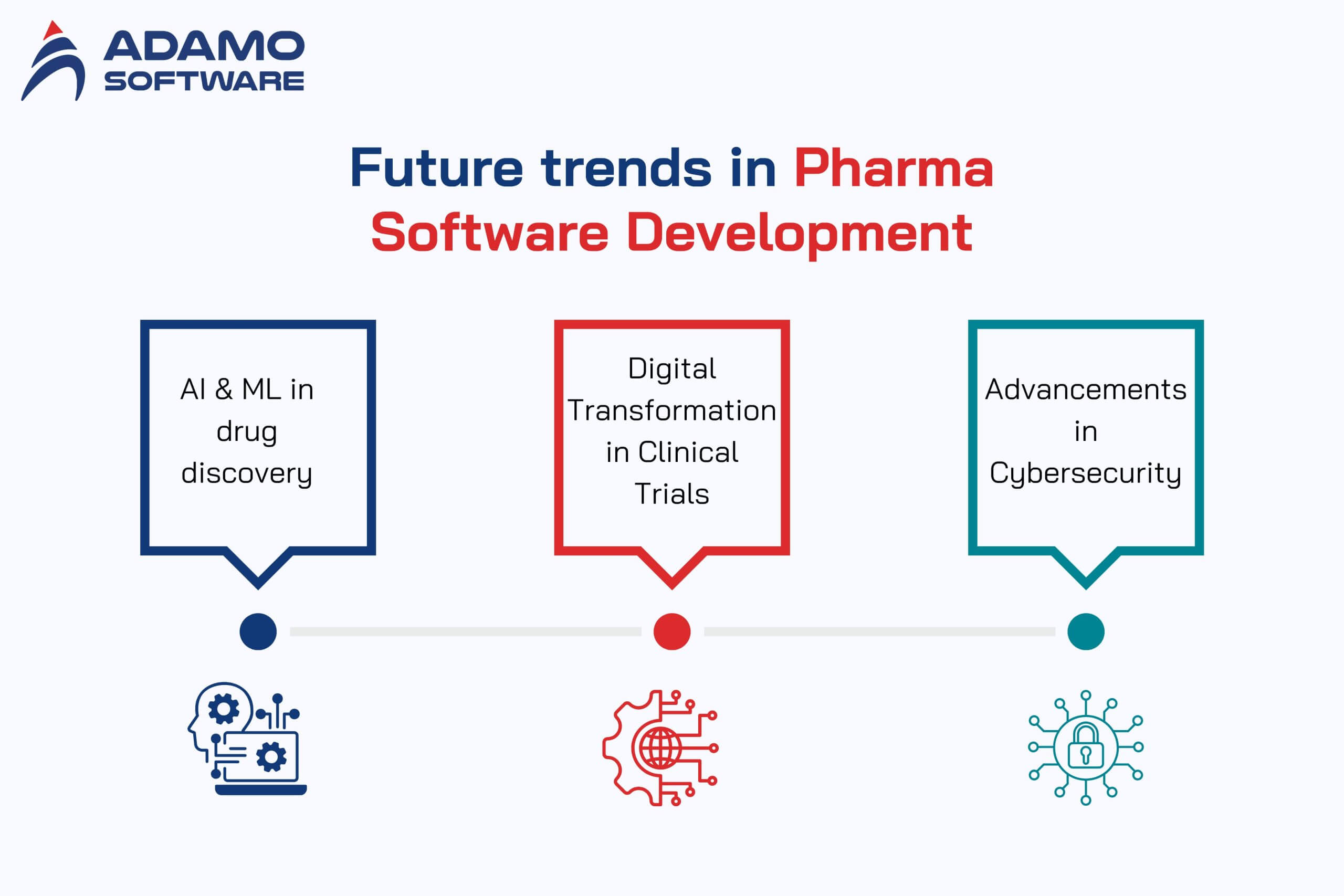
1. AI and Machine Learning in Drug Discovery
AI and Machine Learning are changing the way pharmaceutical companies discover and develop new drugs. With the ability to process and analyze huge amounts of data from clinical studies, scientific literature, and patient data, these technologies help shorten the time to find potential drugs and increase the accuracy in predicting treatment effectiveness.
Some pharma software such as SAS Drug Development has applied advanced statistical algorithms combined with AI to streamline the entire process from research to new drug development. This is a direction that helps businesses speed up drug launches while reducing research costs – a vital factor in the fiercely competitive pharmaceutical industry.
2. Digital Transformation in Clinical Trials
Digital technologies are gradually changing the way clinical trials are conducted. The use of wearable devices to monitor health and collect data in real time helps ensure accuracy, transparency, and continuity throughout the research process.
Telemedicine software is also increasingly popular, helping patients participate in trials more conveniently without going to the hospital. This both expands access and improves treatment outcomes for patients.
Integrating these digital solutions helps pharmaceutical companies optimize the clinical trial process while shortening the time to bring new drugs to market.
3. Advancements in Cybersecurity
In the pharmaceutical sector, ensuring the security of sensitive data is crucial given its critical nature and the severe ramifications that could result from any breaches. The stakes are high with potential financial repercussions, endangering patient safety, and influencing adherence to regulatory requirements when it comes to protecting this vital information.
With the increasing sophistication of cybersecurity threats, pharmaceutical companies must invest heavily in security infrastructure, from data encryption to multi-layered authentication and compliance with standards such as HIPAA or GDPR. Additionally, security upgrades help businesses mitigate risks and ensure compliance in an increasingly stringent environment.
IV. Digital acceleration in pharma software with Adamo Software
Adamo Software specializes in providing tailor-made digital health solutions that help pharmaceutical companies accelerate operations and maintain compliance. Our software integrates seamlessly across departments, supporting everything from manufacturing to supply chain management with advanced features designed for the pharmaceutical industry.

By combining automation, cloud technology, and AI analytics, we enable pharmaceutical companies to improve data accuracy, streamline workflows, and get products to market faster. Partner with Adamo today to accelerate your digital transformation and stay ahead in a highly regulated and competitive marketplace.
FAQs
1. Is it possible to integrate a new pharma software solution into an already existing network?
It is possible, but the integration time will depend on whether your system allows integration, whether the business plans to build a software ecosystem, and whether the developers need to remove legacy components that hinder integration.
This process may sometimes require a system reorganization, which may impact other connected systems. Contact the Adamo team to discuss your case, get possible scenarios, and estimate the project implementation time.
2. How to know if the pharmacy software is HIPAA- or GDPR-compliant?
Testing and assessing HIPAA and GDPR security requirements is the best way to determine whether your software meets compliance standards. Whether you choose a pre-packaged solution or custom software, make sure the vendor develops the product according to compliance guidelines and has specific testing results related to data storage, transmission, security, etc.
3. How much will it cost to develop a pharma software solution for a mid-sized pharma company?
There are many factors that affect the cost, including: desired features, integration with existing systems, volume of data to be converted, tools to be used, etc. In order to provide an initial cost estimate, developers need to know the scope of work and the software functionality you want to build. Therefore, we always organize a meeting (in person or online) to discuss all the details, thereby providing the most realistic quote.
4. Why do software and technology matter in the new age of pharma marketing?
Software and technology play a key role in the new era of pharmaceutical marketing as they enable precise targeting, increased digital engagement, data-driven decision making, regulatory compliance, and operational efficiency. These advancements can help businesses stay competitive in a constantly changing marketing landscape by reaching the right audience with the right message, harnessing data for effective campaigns, ensuring compliance, and streamlining marketing processes.







